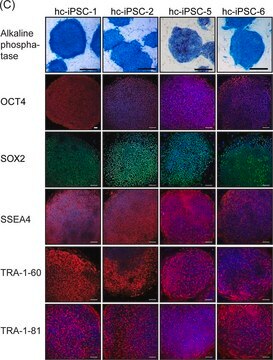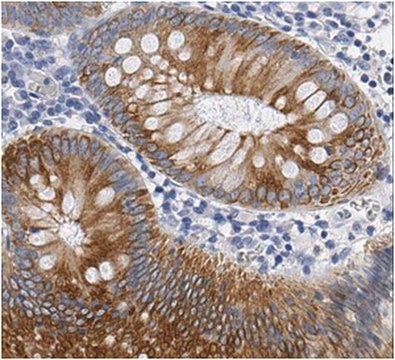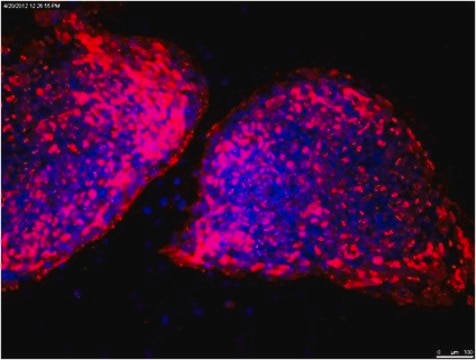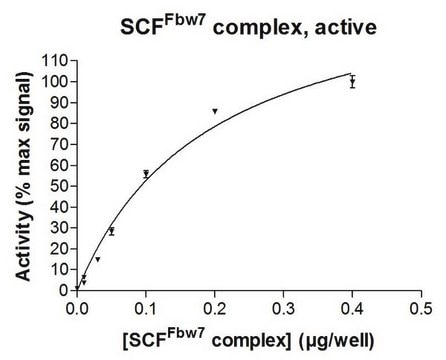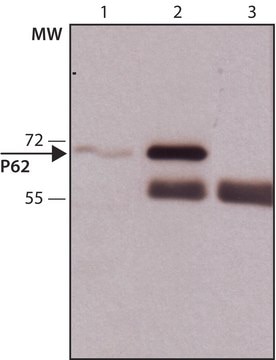MAB4360A4
Anti-TRA-1-60 Antibody, clone TRA-1-60, Alexa Fluor™ 488 Conjugate
clone TRA - 1-60, from mouse, ALEXA FLUOR™ 488
Sign Into View Organizational & Contract Pricing
All Photos(1)
About This Item
UNSPSC Code:
12352203
eCl@ss:
32160702
NACRES:
NA.41
Recommended Products
biological source
mouse
Quality Level
conjugate
ALEXA FLUOR™ 488
antibody form
purified antibody
antibody product type
primary antibodies
clone
TRA - 1-60, monoclonal
species reactivity
human
technique(s)
immunocytochemistry: suitable
isotype
IgM
shipped in
wet ice
target post-translational modification
unmodified
Gene Information
human ... PODXL(5420)
General description
Human embryonal carcinoma (EC) cells are the stem cells of teratocarcinomas, and they are key components of germ cell tumors (GCTs). They express several high molecular weight glycoprotein antigens that are down-regulated upon differentiation. One of these antigens, defined by monoclonal antibody TRA-1-60, can be detected in the serum of GCT patients and provides a useful complement to the established serum markers human chorionic gonadotropin and α-fetoprotein, especially in those patients without elevated serum human chorionic gonadotropin or α-fetoprotein.
Specificity
This antibody reacts with TRA-1-60 antigen expressed upon the surface of human EC, EG, and ES cells. No immunoreactivity is seen with murine EC, EG or ES cells. TRA-1-81 (MAB4381A4) and TRA-1-60 monoclonal antibodies recognize antigens that are associated with a pericellular matrix proteoglycan.
Immunogen
Human embryonal carcinoma cell line 2102Ep
Application
Detect TRA-1-60 using this Anti-TRA-1-60 Antibody, clone TRA-1-60, Alexa Fluor 488 Conjugate validated for use in IC.
Research Category
Neuroscience
Neuroscience
Quality
Evaluated by Immunocytochemistry in H9 human embryonic stem cells.
Immunocytochemistry Analysis: A 1:200 dilution of this antibody detected TRA-1-60 in H9 human embryonic stem cells.
Immunocytochemistry Analysis: A 1:200 dilution of this antibody detected TRA-1-60 in H9 human embryonic stem cells.
Physical form
Purified mouse monoclonal IgM conjugated to Alexa Fluor™ 488 in PBS with 0.1% sodium azide and 15 mg/mL BSA.
size exclusion
Storage and Stability
Stable for 1 year at 2-8°C from date of receipt.
Analysis Note
Control
H9 human embryonic stem cells
H9 human embryonic stem cells
Legal Information
ALEXA FLUOR is a trademark of Life Technologies
Disclaimer
Unless otherwise stated in our catalog or other company documentation accompanying the product(s), our products are intended for research use only and are not to be used for any other purpose, which includes but is not limited to, unauthorized commercial uses, in vitro diagnostic uses, ex vivo or in vivo therapeutic uses or any type of consumption or application to humans or animals.
Not finding the right product?
Try our Product Selector Tool.
wgk_germany
WGK 2
flash_point_f
Not applicable
flash_point_c
Not applicable
Certificates of Analysis (COA)
Search for Certificates of Analysis (COA) by entering the products Lot/Batch Number. Lot and Batch Numbers can be found on a product’s label following the words ‘Lot’ or ‘Batch’.
Already Own This Product?
Find documentation for the products that you have recently purchased in the Document Library.
Yohei Hayashi et al.
Communications biology, 1, 218-218 (2018-12-12)
Conventional cell handling and sorting methods require manual labor, which decreases both cell quality and quantity. To purify adherent cultured cells, cell purification technologies that are high throughput without dissociation and can be utilized in an on-demand manner are expected.
Kung-Kai Kuo et al.
Stem cells (Dayton, Ohio), 34(11), 2613-2624 (2016-06-25)
The network of stemness genes and oncogenes in human patient-specific reprogrammed cancer stem cells (CSCs) remains elusive, especially in liver cancer. HepG2-derived induced pluripotent stem cell-like cells (HepG2-iPS-like cells) were generated by introducing Yamanaka factors and the knockdown vector shTP53.
Ning Sun et al.
Proceedings of the National Academy of Sciences of the United States of America, 106(37), 15720-15725 (2009-10-07)
Ectopic expression of transcription factors can reprogram somatic cells to a pluripotent state. However, most of the studies used skin fibroblasts as the starting population for reprogramming, which usually take weeks for expansion from a single biopsy. We show here
Vanessa Sauer et al.
Cell transplantation, 25(12), 2221-2243 (2016-08-12)
Although several types of somatic cells have been reprogrammed into induced pluripotent stem cells (iPSCs) and then differentiated to hepatocyte-like cells (iHeps), the method for generating such cells from renal tubular epithelial cells shed in human urine and transplanting them
Our team of scientists has experience in all areas of research including Life Science, Material Science, Chemical Synthesis, Chromatography, Analytical and many others.
Contact Technical Service